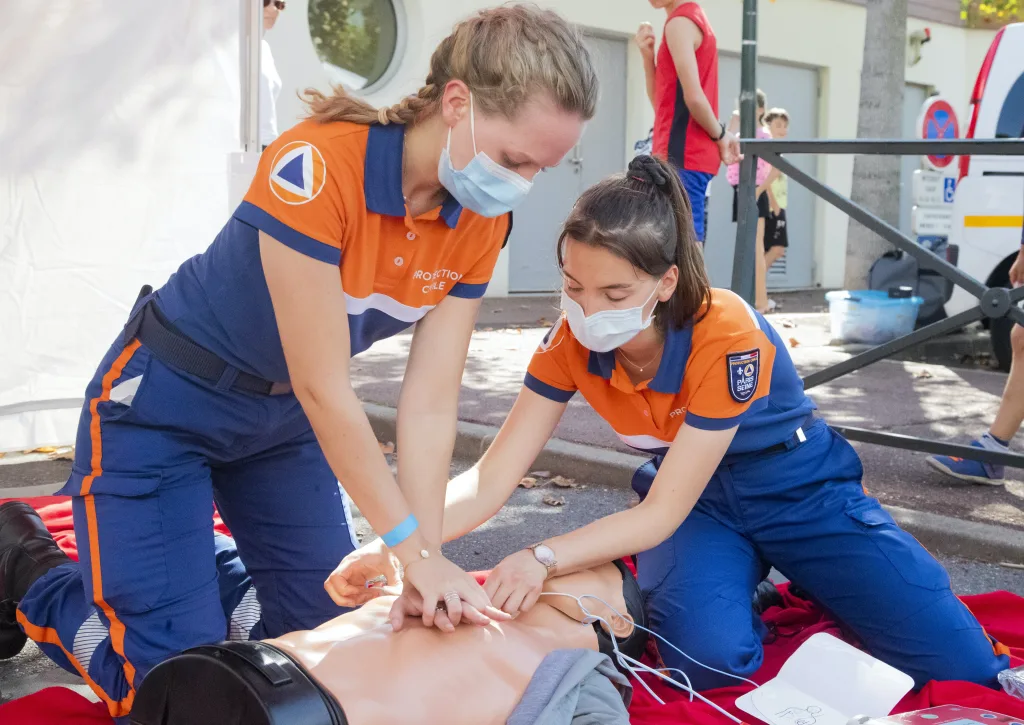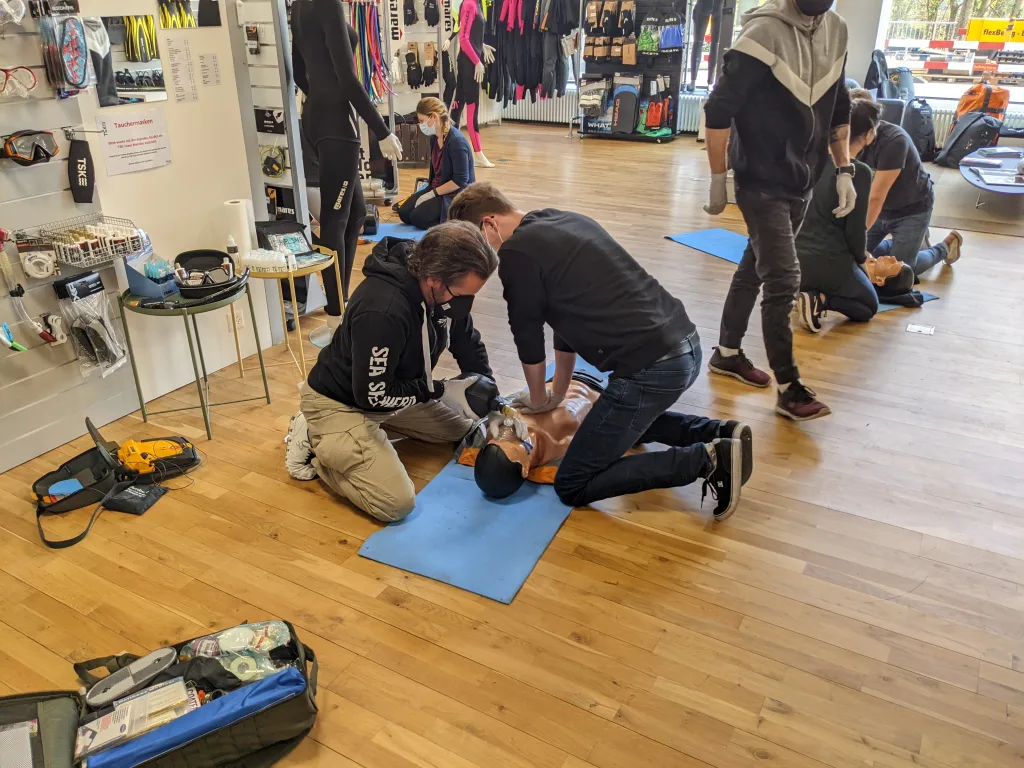Performing CPR (Cardiopulmonary Resuscitation) is a crucial life-saving technique that can significantly increase the chances of survival for someone experiencing cardiac arrest. However, it is important for rescuers to know when and how to switch positions during CPR to ensure the effectiveness and efficiency of the resuscitation efforts.
When it comes to CPR, time is of the essence. The primary goal is to maintain blood circulation and oxygenation to vital organs, especially the brain, until advanced medical help arrives. Chest compressions play a vital role in achieving this goal by manually pumping the heart and keeping the blood flowing. However, performing chest compressions can be physically demanding and tiring for the rescuers.
To prevent rescuer fatigue, it is recommended to switch positions approximately every two minutes or after every five cycles of compressions and breaths. This allows each rescuer to take turns performing the physically demanding chest compressions while the other rescuer provides rescue breaths and monitors the victim’s airway.
In a two-person resuscitation, the rescuers should coordinate their efforts to ensure a smooth transition during the position switch. One rescuer is positioned near the chest area, providing continuous and uninterrupted compressions, while the other rescuer is positioned near the victim’s head, opening the airway and delivering rescue breaths. This teamwork ensures that the victim receives the necessary compressions and breaths without any interruption.
It is important to note that interrupting chest compressions, even for a short period, can significantly decrease the effectiveness of CPR. Interruptions can lead to a decrease in blood circulation and oxygenation, which can be detrimental to the victim’s chance of survival. Therefore, it is crucial for rescuers to switch positions efficiently and quickly, minimizing any breaks in chest compressions.
During the position switch, the rescuer near the chest area should ensure that the compressions are not interrupted while the other rescuer takes over the chest compressions. The rescuer near the head should swiftly move into position, open the victim’s airway, and provide rescue breaths. Effective communication and coordination between the rescuers are essential to maintain the flow of CPR and maximize the chances of a successful resuscitation.
During CPR, rescuers should switch positions approximately every two minutes or after every five cycles of compressions and breaths. This allows for the distribution of physical exertion and prevents rescuer fatigue. It is important to coordinate and communicate effectively to ensure a smooth transition during the position switch, minimizing any interruptions in chest compressions. By following these guidelines, rescuers can provide effective and continuous CPR, increasing the chances of survival for someone experiencing cardiac arrest.
When Should Rescuers Switch Positions During CPR?
Rescuers should switch positions during CPR approximately every 2 minutes. It is important to rotate rescuers regularly to prevent fatigue and ensure the effectiveness of chest compressions. When performing CPR, rescuers need to exert a significant amount of physical effort, which can lead to exhaustion over time. Fatigue can result in inadequate chest compressions, reducing the chances of successful resuscitation.
To maintain the quality and consistency of CPR, the American Heart Association (AHA) recommends rotating rescuers every 2 minutes or after every 5 cycles of CPR. This allows each rescuer to take turns performing chest compressions and providing rescue breaths, if applicable. By switching positions, rescuers can rest and recover, ensuring they can deliver effective chest compressions with proper depth and rate.
During the rotation, it is essential to ensure a smooth transition to avoid interruptions in chest compressions. Rescuers should communicate clearly and coordinate the switch to minimize any delays. The incoming rescuer should be ready to take over before the outgoing rescuer stops compressions.
To facilitate the rotation of rescuers during CPR, organizations may implement specific protocols or use tools like a metronome or timer to keep track of time. These aids can help maintain the consistency and accuracy of chest compressions, as well as ensure timely rotations.
Rescuers should switch positions during CPR approximately every 2 minutes or after every 5 cycles of CPR. This rotation helps prevent rescuer fatigue and ensures the delivery of effective chest compressions. Following these guidelines can improve the chances of successful resuscitation during emergency situations.

When Performing 2 Rescuers CPR How Often Should You Switch Roles?
When performing 2 rescuer CPR, it is recommended to switch roles after every five cycles of compressions and breaths. This means that after one rescuer completes five sets of 30 compressions and two breaths, the other rescuer takes over and performs the next five cycles.
Switching roles regularly is important to prevent rescuer fatigue and maintain the quality of CPR. The continuous chest compressions can be physically demanding, and rotating roles ensures that each rescuer has an opportunity to rest and recover their strength. By alternating roles, the rescuers can sustain effective chest compressions and deliver adequate oxygenation through rescue breaths.
To facilitate the switching of roles smoothly, it is helpful to establish clear communication and coordination between the rescuers. They should agree on a signal or verbal cue to indicate when it’s time to switch. This can be done at the beginning of the CPR process to ensure a seamless transition between the rescuers.
By adhering to the guideline of switching roles after every five cycles of compressions and breaths, rescuers can work together effectively and provide continuous and high-quality CPR to the person in need.
When Performing CPR When Should You Switch Positions And Allow Someone Else To Take Over Compressions And Breaths?
When performing CPR, it is recommended to switch positions and allow someone else to take over compressions and breaths after about every two minutes. This is particularly important when two trained personnel are present at the scene. The two rescuers should coordinate their efforts to ensure effective chest compressions are performed continuously.
During the two-person resuscitation, one rescuer is positioned near the chest area and is responsible for performing chest compressions. The other rescuer is positioned near the head of the victim and is responsible for providing breaths, either through mouth-to-mouth or using a bag-valve-mask device.
Switching positions and rotating roles every two minutes helps prevent fatigue, ensuring that both rescuers can maintain the necessary level of effectiveness and provide high-quality CPR. Fatigue can significantly impact the quality of chest compressions, reducing the blood flow and potentially compromising the chances of successful resuscitation.
By alternating positions, the rescuers can take turns in performing the physically demanding chest compressions while also providing an opportunity for the other rescuer to take a breather and maintain their focus and energy levels. This rotation allows for sustained and efficient CPR delivery, increasing the chances of a positive outcome for the victim.
It is important to note that the exact timing of position switches may depend on the specific guidelines and protocols followed by the rescuers’ training organization or medical authority. However, the general recommendation is to switch positions approximately every two minutes to ensure optimal performance and minimize rescuer fatigue.
When performing CPR with two trained rescuers, it is advisable to switch positions and allow someone else to take over compressions and breaths approximately every two minutes. This rotation helps maintain the quality of CPR and reduces the risk of fatigue, ultimately improving the chances of successful resuscitation.
When Should CPR Compressors Switch Roles?
CPR compressors should switch roles approximately every 2 minutes or every 5th cycle of chest compressions. This is important because performing chest compressions is physically demanding and can quickly lead to fatigue. By switching roles, the rescuers can ensure that they maintain the quality and effectiveness of the compressions.
Interrupting chest compressions, even briefly, can disrupt the circulation of blood and oxygen to the vital organs. Therefore, it is crucial to minimize any interruptions during the CPR process. By rotating the compressors every 2 minutes, the rescuers can avoid exhaustion and maintain the necessary level of force and pace required for effective chest compressions.
Here is a breakdown of the recommended CPR compression switch:
1. Start with one rescuer performing chest compressions while the other rescuer supports the head and performs rescue breaths.
2. After 2 minutes or every 5th cycle of compressions, the rescuers should switch roles.
3. The rescuer performing chest compressions should move to support the head and perform rescue breaths.
4. The rescuer who was supporting the head should take over chest compressions.
5. This rotation allows for a fresh rescuer to provide effective compressions while the other rescuer can recover and focus on rescue breaths.
By following this rotation schedule, the rescuers can maintain the quality and continuity of chest compressions, increasing the chances of a successful CPR outcome.

Conclusion
CPR is a critical life-saving technique that requires coordination and teamwork. The importance of switching positions during CPR cannot be overstated. Rescuers should switch roles every two minutes or after every five cycles of compressions and breaths.
Switching positions allows for a fresh rescuer to take over the physically demanding task of performing chest compressions, as this can quickly become exhausting. By alternating roles, rescuers can maintain the quality and effectiveness of compressions, which is vital for maintaining circulation and increasing the chances of survival.
Interrupting chest compressions, even for a brief moment, can have detrimental effects on the person in need of CPR. The continuous flow of compressions is crucial for maintaining blood flow and oxygenation to the vital organs. Therefore, the timely switching of positions ensures that there is no interruption in the circulation and maximizes the chances of a successful resuscitation.
Furthermore, in a two-person resuscitation scenario, the coordination between rescuers is essential. By working together and synchronizing their efforts, they can provide high-quality chest compressions and rescue breaths, ultimately increasing the person’s chances of survival.
The process of switching positions during CPR is a crucial aspect of providing effective and continuous life support. It helps to prevent fatigue, maintain the quality of compressions, and avoid interruptions in circulation. By following these guidelines, rescuers can optimize their efforts and significantly improve the chances of a successful outcome in a cardiac arrest situation.
